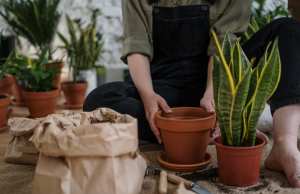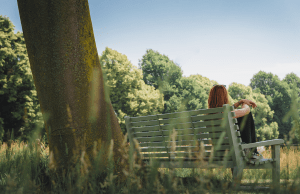
- Green spaces offer us an abundance of mental health benefits, whether that space is a home garden, lawn, or collection of house plants.
- The color green has a short wavelength and is easy for our eyes to pick up—plus, shades of green have been shown to promote relaxation, encourage positive mood, and boost our sense of optimism.
- Zen gardening, which is more of a state of mind than anything else, offers the chance to come to terms with deeper sources of anxiety, like death, dysfunctional relationships, and unfulfilled desires.
- So whether you decide to garden, window shop at a local nursery, decorate your home’s interior, or find a knack for lawn care or landscaping, getting in touch with your chosen greenspace can help you gain a sense of emotional balance.
Wiping the dark southern clay from my palms, I prop myself back up on my knees, squinting under the weight of the amber sun. The air around me is dripping with moisture, and birds and insects drone in waves outside the edges of my vision. The young garden around me pulses with life under the heat of a San Antonio spring morning.
I’ve finished pulling the weeds right before the hottest part of the day. I rise to my feet and wash off my muddy sneakers under the brawny limbs of a few gnarled shade trees. Their tender green leaves sway slightly, and the water hose splashes against a baby-blue sky. I watch the droplets cling cool and clear to my skin, against a breeze that ruffles my t-shirt.
I love gardening. I think something happens to us when we become invested in the well-being of green and growing things. When we pay attention to the inescapable cycle of birth, death, health, and disease that occurs in the green spaces we created I believe that we’re better able to begin processing our own role in that cycle, too. Like the gardens, lawns, and houseplants we tend to, we’re just trying to grow wherever we’ve been planted.

Why Our Brains Prefer Shades of Green
Between all five senses, most of the human experience is processed through our visual cortex; this just means we’re sight-oriented animals. This may explain why colors have such a profound psychological impact on our emotions. Compared to other colors, shades of green in particular are very easy for our eyes to pick up and promote positive emotions. This is because green has a shorter wavelength, which means our eyes don’t need to adjust much to take it in.
Research also indicates that the color green can stimulate feelings of relaxation, happiness, health, and optimism. Evolution probably has a bit to do with our preference and positive reaction to the color green. Environments that are rich with plant life are a sign of safety, and are likely to be abundant with food, water, and shade from the sun. Perhaps our primitive roots partially explain our preference for shades of green.
Could a Zen Mentality Turn You Into a Backyard Buddha?
Perhaps you’ve managed to kill your houseplants in the past, or maybe you predict that your experience with gardening will be frustrating, repetitive, and time-consuming. It could be—with that attitude. But forget about that for a moment, and instead imagine a white blossom as it develops on the branch of an apple tree. If you spent several months observing this single blossom, you’d watch as:
- Summer turns to fall, and the blossom develops into an apple, changing from bright green to a full and vibrant pink shade.
- The fruit ripens and grows larger and eventually falls to the ground, rolling away from the tree.
- This once-sweet, fragrant fruit begins to fall apart, as its firm flesh begins rotting and grows soft.
- The disintegrating flesh of the apple becomes unappealing and disturbing to our eyes and nose, but the process fertilizes the soil beneath the apple. Now the seed it contains can grow into a new tree.
And so the cycle of change continues. Referred to as impermanence in Zen Buddhist philosophy, Zen practitioners believe that constant change is the ultimate nature of the physical world. By ignoring the fact that our bodies, and the people, places, objects, and physical pleasures we love won’t last forever, we create unnecessary suffering for ourselves and others. And sometimes, unexpected factors may alter our plans—meaning the only thing in life we can truly control is our responses to the events we live through.
Zen gardens help practitioners to accept the impermanence of life, and to see change as a force that’s both beautiful and necessary. Just like a Zen garden, your own lawn, garden, or collection of house plants, is a green space that requires regular maintenance. But despite our regular maintenance, one day the garden will be gone. Through cultivation and observance of what happens in your garden, and your own attempts to preserve it, you have the opportunity to make peace with impermanence both internally and externally.
Even if it’s a bit too much to expect yourself to feel blissed out while trimming the Bermuda grass, one study concluded that simply mowing your lawn can improve your mental health. But there’s also no need to commit to a whole day in the backyard, either. Another experiment published results indicating that people who spend only 30 minutes gardening show significantly reduced cortisol levels compared to those who spend 30 minutes reading instead.
4 Ways to Cultivate Your Own Green Space
If you’re pining for a green space of your own, there are several ways to begin cultivating a home garden, a lawn, or community of house plants. All of these options can benefit your mental health, because it’s the care and time that you spend looking after them that matters most. You might begin by:
- Embarking on a YouTube deep-dive to learn how to start home gardening: Though my family taught me a lot about homesteading, I needed a refresher on how to get back into home gardening. YouTube became an endless resource for tips, tricks, and creative ideas for how to make the most out of my green space. By trying new and unfamiliar techniques, I’m also able to get outside my comfort zone, a surefire way to encourage self-growth.
- Taking a walk through your local plant nurseries to shop, network, and get an idea of what you might like to grow: I love walking my dog at many of the local parks, but sometimes we switch things up and head to a nursery, instead. We’re both able to get exercise, take in some fresh air, and check out a huge variety of plants. It’s hard to be in a bad mood around a banana tree (trust me, I’ve tried). Plus, there are always like-minded people who I can talk to and learn more about their green spaces and home gardening projects.
- Finding a way to decorate your home with house plants: Though house plants can be decidedly more difficult to care for than outdoor species, having plants inside can help filter your home’s air and cut back on pollutants that you might not even be aware you’re breathing in. Plus, with the extra greenery to add a sense of coziness and a natural atmosphere, you can cut back on stress and use your brain’s preference for green colors to make your home a more positive and relaxing environment. There are even indoor herb and vegetable kits that can be found online.
- Starting a lawn care or landscaping project: A beautiful, emerald green lawn is no easy task, which is why the lawn care community on TikTok is on an entirely different level. Learn from the masters by watching their hilarious and viral videos. Another fun idea is to work with your hands—create a stone pathway, construct a water feature or research which native plants will suit your home’s yard best. Accomplishing a DIY landscape project will boost your home’s value and leave you with a sense of fulfillment.
And so later that evening, as the crickets and junebugs start fiddling their songs, and the dim city stars come out to dance, I head outside. Under the glow of the porch light, I can see the stark difference between what’s growing inside my garden and what lies just beyond its borders. Without me controlling the chaos, within a month, I know that each carefully-tended row of produce would be overrun.
No matter how many weeds I manage to pull, there will always be more. Until one day, when I’m gone, everything that lies outside my garden’s fence will reclaim what I’ve built. And somehow, I’m learning how to be okay with that.













